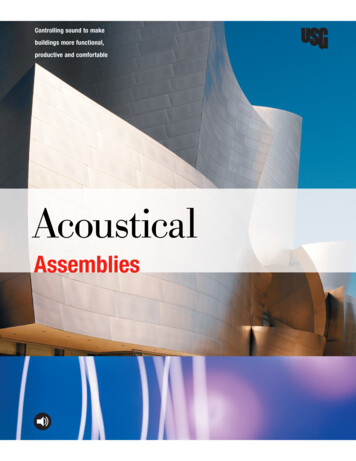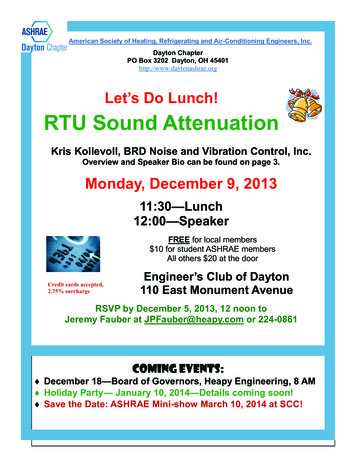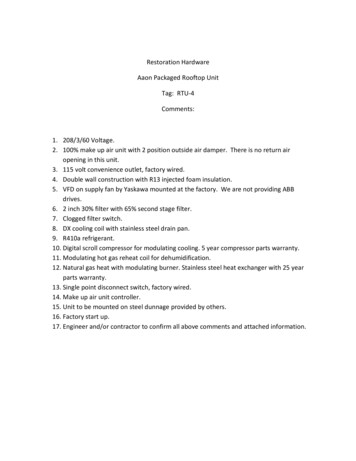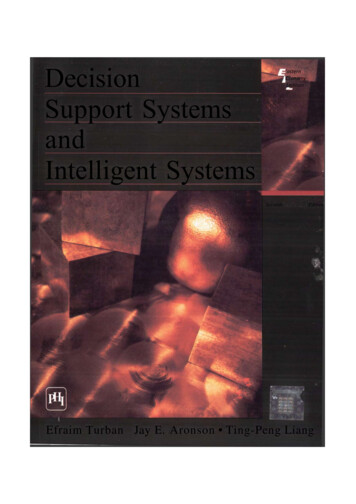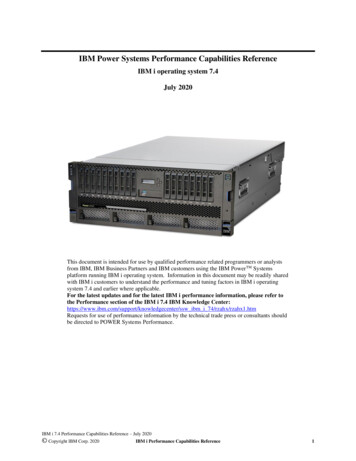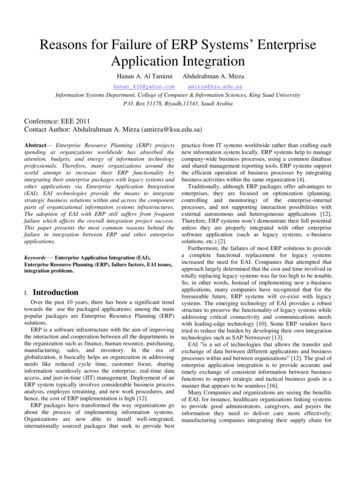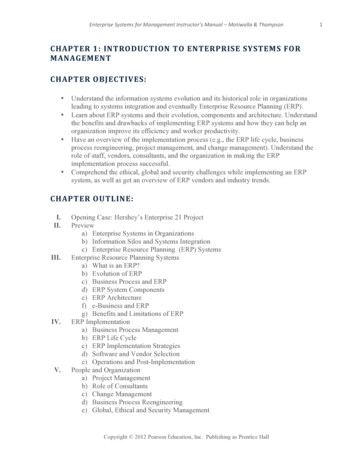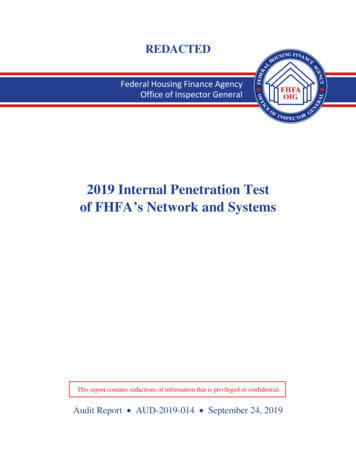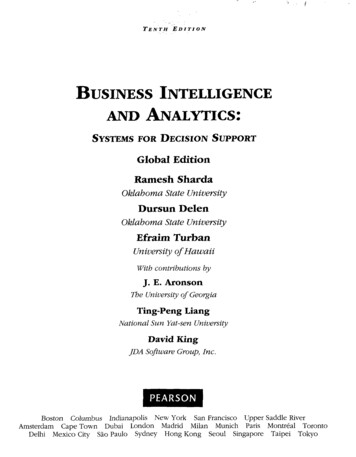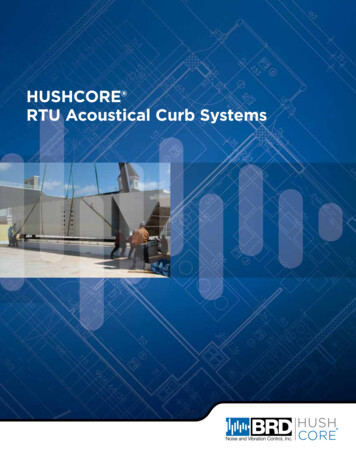
Transcription
HUSHCORE RTU Acoustical Curb Systems
Curb Mounted Rooftop Unit (RTU) Problem FanBreakoutBreakoutRegeneratedRadiatedMulti-Path System Problems Require Comprehensive System SolutionsBRD HUSHCORE Solutions have been helping keep Business, Education,Healthcare and Entertainment facilities quiet, inside and outside, since 1975.2 From Problem Definition. to Problem SolvedStructure-Borne
RTU Noise Transmission OutdoorFan NoiseSome fan types generate higher sound levels than others, but all supply and return airfans will generate sound that travels in duct to diffusers servicing occupied buildingspaces. Fan noise is often the primary transmission path except when RTUs are locateddirectly above the space they service where the radiated path may dominate. Payattention to frequency octave band data to address fan blade passage tones.Radiated NoiseRadiated noise is the sound radiating from the unit cabinet through the roof deck insidethe RTU curb confines. Radiated noise is most significant in RTUs with DX cooling havinga condensing section with compressors and cooling fans. In-curb acoustical treatmentsaddressing the radiated path should include provisions for sealing around duct drops.Structure-Borne NoiseAny structure that vibrates radiates airborne sound. Structure-borne vibration if notisolated at the unit by the RTU curb can excite building structural components. Roofsteel, metal decking and gypsum board partitions are very efficient transmitters ofvibration. Ductwork inside the building must also be isolated from structure.Duct Breakout NoiseBreakout noise is sound passing through the walls of ductwork and silencer casings. Itis a function of the component shape and size. Breakout noise is the reason to placesound attenuators as close to the unit as possible. Breakout noise is usually greatest inthe first elbow and 1O’ to 12’ of ductwork directly below the RTU in a downflow SupplyAir (SA)/Return Air (RA) configuration.Regenerated NoiseRegenerated noise is noise attributable to obstructions and discontinuities that createturbulence in the otherwise smooth flow of air in duct systems. Probability for turbulenceand regenerated noise is greatest at the first duct drop elbows. Regenerated noisetransmits in duct downstream and also radiates through the breakout path.Outdoor NoiseOutdoor noise is the radiated sound path to nearby community receptor locations. Thesound pressure level at a given property line location is a function of the decay rate fora given distance and site influence of nearby grade, roof and/or building wall reflectingplanes. Outdoor noise is of greatest concern for RTUs with DX cooling that incorporatea condensing unit section containing scroll compressors and condenser cooling fans.From Problem Definition. to Problem Solved.Learn more at www.hushcore.net or call 610-863-6300BRD Noise and Vibration Control, Inc. 3
Multi-Path HUSHCORE System SolutionsHUSHCORE Acoustical Vibration Curb OverviewDuct (by others)Seismic RestrainedIsolatorsDuct Drop RailsAirSupF l owplyHUSHCORE HICVibration Isolation CurbDeck SystemIn-Curb TreatmentAirF l owRe tHUSHCORE turnkey or A LaCarte solutionsare available forgreatest designflexibility.HUSH DUCT Elbow AttenuatorurnHUSHCORE RTU Acoustical Curb Systems Selection GuidelinesThe table below shows various HUSHCORE System models with the transmission paths they address.HUSHCORE Acoustical Curb System Standard System Plus System Whisper “P” System Standard “E” System Plus “E” System Whisper “E” System Whisper “V” System Ultra System Custom dFanRadiatedStructure-BorneBreakoutRegenerated Comments Excellent strategy for specifying repeatable Entry Level“Best Practices” All these Systems have HDESHUSH DUCT fan attenuationsilencers at the roof deck supply and return air openings These designs require curbheights of 36” to 60” to allowfor integrated HUSH DUCTS inside the curb. Serviceplatforms can be integratedinto the taller curbs Please visit our website www.hushcore.net for more information about our A La Carte, Entry Level,High Performance and Custom Design acoustical curbs. CAD details and guide specifications areavailable for project bid documents and drawings.4 From Problem Definition. to Problem Solved
Three Levels of HUSHCORE TechnologyHUSHCORE Entry Level SystemsDirect ducted designs with fan attenuation addressed elsewhereHUSHCORE Plus SystemBase System(HIC koutBase System(HIC Curb)HVAC UnitReturnRadiatedSupplyDeck SystemRoof DeckAir FlowAir FlowHUSHCORE High Performance SystemsPlenum curbs with silencers at deck openingsHUSHCORE Whisper “E” SystemBase System(HPC Curb)Base System(HPC Curb)HVAC UnitReturnAir FlowDeck SystemAir FlowSupplyRegeneratedRoof DeckHUSH DUCT Elbow SilencersHUSHCORE Custom SystemsComplete plenum curb integrated designsHUSHCORE Ultra SystemBase System(HPC Curb)Base System(HPC Curb)HVAC UnitReturnRadiatedStructure-BorneBreakoutAir FlowSupplyAir FlowDeck SystemFanRegeneratedRoof DeckHUSH DUCT Integrated SilencersBRD Noise and Vibration Control, Inc. 5
HUSHCORE Entry Level SystemsHUSHCORE Plus SystemBase System(HIC Curb)Base System(HIC Curb)HVAC UnitReturnSupplyDeck SystemRoof DeckAir FlowAir FlowAdvantages of Using HUSHCORE Deck Systems for In-CurbAcoustical Treatment of RTU Radiated NoiseRadiatedStructure-BorneHUSHCORE Deck Systems provide designers/specifiers with due diligence and knownperformance that is not achievable with a traditional gypsum board and batt insulation.HUSHCORE Deck Systems Proven Solutions6Gypsum Board & Batt Insulation StrategyPerformance Independently tested w/range of attenuation UnknownCommissioning Submittal required per new specification withprovision for site inspection/verification No submittals 100% confidence providedNo site verification required/specified50/50 chance it made it in the curbWeight Weighs less but performs better due to labtesting optimization and research Weighs more but performs lessCost Provides the best value considering installedcost and greatest dBA reductions per dollarspent Lower first cost of materials but no costadvantage considering proper installationlabor requiredInstallation Details specified, including sealing Flexible materials allow tighter fit and fillingof tight spacesNo specification direction regarding sealing(#1 issue for sound control loss) Rigid materials create challenges fortight spaces and increase the potentialfor resonance No special tools required Commissioning site verification ensuresconsistent quality No special tools required From Problem Definition. to Problem Solved
HUSHCORE Deck System In-Curb Research &Development Performance Optimization ProcessHUSHCORE R&D efforts have assisted BRDNoise and Vibration Control Inc. in optimizingmaterial selection and construction for maximumperformance. Mock-up testing is done in aNAVLAP certified 3rd party laboratory to theASTM E90 test procedure. The picture belowis from our latest round of R&D testing. Thepreferred method for determining the STC ratingof a product (ASTM E90) is officially called the“Standard Method for Laboratory MeasurementRadiatedof Airborne Sound Transmission”. During an ASTME90 test, a test specimen is mounted between aroom containing an isolated source of noise anda receiving room. Sound transmission loss, thedifference between the sound level in the sourceroom and the receiving room, is measured atspecific sound frequencies and used to arriveat the STC rating. The higher the STC ratingmeasured, the quieter it is in the receiving room.ASTM E90 – “Standard Test Method for LaboratoryMeasurement of Airborne Sound Transmission”Results of multiple R&D efforts teach us the following:1. In-curb performance is oftencounter-intuitive and difficult topredict or calculate.3. Flexible insulations and massbarriers outperform rigidmaterials of comparable mass.2. More is not always better so filling upthe RTU curb is an inefficient solutionand may yield lower performance.4. In-curb acousticaltreatments adhere to the lawof diminishing return above 8” thick.The table below summarizes a sampling of the most cost-effective Deck System Octave Band TransmissionLoss per the ASTM E90 test standard. We are showing full octave performance from 125 Hz to 4000 Hz.Deck SystemModelTransmission Loss Octave Bands (Hz)STCClass AFire 00 152031385053Yes 18264154627041No 192943545768DS-4343Yes - 203049596572DS-4949Yes 293750576471DS-5050No 293853626673DS-5252Yes 334250606471DS-5555No - 344856616468DS-5757Yes 344557626674Contact BRD at info@brd-nonoise.com to obtain full data results at all 1/3 octave frequenciesBRD Noise and Vibration Control, Inc. 7
HUSHCORE High Performance SystemsHUSHCORE Whisper “E” SystemBase System(HPC Curb)Base System(HPC Curb)HVAC UnitReturnAir FlowDeck SystemSupplyAir FlowRoof DeckHUSH DUCT Elbow SilencersAdvantages of Using HUSH DUCT Multi-Path ElbowSilencers to Increase Attenuation of Fan Noise and DuctBreakout Noise While Controlling TurbulenceHUSH DUCT Elbows at Deck OpeningsHUSH SEALANT Roof DeckHUSH DUCT AttenuatorSupplyAir FlowSupplyRoof Deck8RegeneratedBase System(HIC Curb)HVAC UnitAir FlowHUSH SEALANT BreakoutDownstream Straight SilencersBase System(HIC Curb)HVAC UnitFanHUSH DUCT AttenuatorFanBreakoutRegeneratedAcoustical PerformanceBreakout PerformanceAerodynamic PerformanceHUSH DUCT Elbows at DeckOpeningsCan provide greater overalland low frequency acousticalperformance per foot ofcenterline lengthAddresses breakout path atduct drop elbows under RTURadiused internal geometryreduces turbulence andregenerated noiseDownstreamStraightSilencersPerformance limited bystraight duct lengths available.Less Insertion Loss per footDoes not attenuate breakout noise in first duct dropelbowsDownstream location doesnot address self noise(regenerated) of first elbow From Problem Definition. to Problem Solved
Typical HUSH DUCT Construction & OptionsFanBreakout61HUSH DUCT Rectangular25Specialty HUSH DUCT Designs & Options4 Transition Silencers Packless/Fiber-Free Silencers Hospital Grade Silencers Industrial Silencers Tuned Silencers Silencers with AccessibleAcoustical Media Galvanized, Stainless Steel andAluminum Construction3Key1Exterior casing 24 ga. to 10 ga. for high TL2Acoustically transparent perforated steelretaining screen internals3Acoustic standoff spacer for media film4Media film (Fiberglass Cloth, Mylar, or Tedlar)5Acoustical media (Fiberglass or Natural Fiber)6Tested to latest revision of ASTM E477Advantages of Using HUSHCORE Integrated and Pre-AssembledVibration Curbs Instead of Traditional Field Assembled Rail Kits.Structure-BorneShip & PickShip & AssembleConstructionWelded/Fully AssembledMechanically bolted (Erector Set)Quality ControlFactory Quality ControlledSubject to human assembly errorFactory CurbNo factory curb requiredRequires additional factory curbWind/SeismicCAN be designed to meet code wind andseismic loads for all size RTUsCANNOT meet all code wind and seismicloads for all size RTUsValueEliminates field assembly laborFirst cost savings spent on assemblyBRD Noise and Vibration Control, Inc. 9
HUSHCORE Solutions for Air Terminal Units inRooftop Variable Air Volume (VAV) SystemsFanRadiatedVAV/FPVAV Problem Definitionfresh airexhaust airRooftop VAV Systems provide energy efficientcooling and heating using features that allow theunit to vary capacity and airflow. Typical featuresinclude control software, variable frequency drives(VFDs), compressors with staged capacity, andmultiple space sensors. The result is an HVAC System with better temperature and humidity control.variable-speedforced-draft fanair handling unitvariable-speedreturn air fanair outletvariable-volumeboxreturn airWhere VAV units or fan powered VAV (FPVAV)units can be located in the ceiling plenum abovecorridors, bathrooms, utility spaces, etc., soundcan be buffered from noise sensitive spaces suchas classrooms, conference rooms, private offices,etc. Where boxes cannot be buffered or where thebuilding design has exposed ceilings, HUSHCORE Systems can be used to mitigate some or all of thetransmission paths.return airgrilleImage courtesy of Slipstream Group, Inc.VAV Unit Sound Transmission Paths Cabinet Radiated Discharge Primary Air Inlet Induction Fan InletHUSHCORE Premium , Supreme or Zenith System Solutions can address someor all of these paths.ATU Unit Manufacturer63441tl UniminareTAir25101Air Terminal Unit2Primary Air Inlet3Unit Outlet (Discharge)444 From Problem Definition. to Problem SolvedAcoustical Manufacturer4HUSHCORE Premium System Velcro Removable Acoustical Enclosure5HUSHCORE Inlet/Return HUSH DUCT Silencer6HUSHCORE Outlet/Discharge HUSH DUCT Silencer
Noise Ratings for Variable Air Volume (VAV)Boxes and Other Air Terminal Units (ATU)FanRadiatedThe AHRI Standard 880 entitled “Performance Rating of Air Terminals”pertains to air control devices used in air distribution systems thatprovide control of air volume with and without temperature control bymeans that may or may not include a fan. Standard AHRI-885-2008outlines transfer functions to convert certified AHRI-880 sound powerlevels to sound pressure and to a space specific NC level. AHRI-885facilitates accurate comparisons across ATU manufacturers. Usingtransfer functions from earlier version AHRI-885-1998 may understateexpected sound pressure and NC levels in the built environment.Determining ATU Sound Levels Start with Certified Sound Power per AHRI-880-2011 or later revision NC Ratings are not part of AHRI-880 Use transfer functions in AHRI-885-2008 (not 1998 version) for powerto pressure conversion per Appendix E for manufacturer c
HUSHCORE R&D efforts have assisted BRD Noise and Vibration Control Inc. in optimizing material selection and construction for maximum performance. Mock-up testing is done in a NAVLAP certified 3rd party laboratory to the ASTM E90 test procedure. The picture below is from our latest round of R&D testing. The
